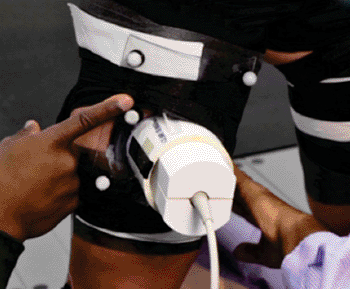Vector Tissue Doppler Ultrasound Effective Tool for Imaging Muscle, Tendon Motion
By MedImaging International staff writers
Posted on 07 Oct 2013
Scientists have developed a new approach that utilizes a Doppler ultrasound for quantifying muscle kinematics. The new technology, which has been designed to image muscle and tendon motion during dynamic tasks, can provide a complementary methodological tool for biomechanical studies in a clinical or laboratory setting. Posted on 07 Oct 2013
Injured and painful joints feature complicated dynamics the understanding of which can help clinicians figure out how to address a variety of conditions. To visualize the processes involved in muscle and tendon dynamic tasks, the patient has to be imaged while using the injured joint.

Image: Scientists have developed a new approach that utilizes a Doppler ultrasound for quantifying muscle kinematics (Photo courtesy of George Mason University).
The investigators have developed an innovative vector tissue Doppler imaging (vTDI) technique that can be used to measure musculoskeletal contraction velocity, strain, and strain rate with submillisecond temporal resolution during dynamic activities using ultrasound. The researchers from George Mason University (Fairfax, VA, USA) have devised the new technology that uses existing modalities to provide a comprehensive picture as to how the musculoskeletal parts of the leg function.
Little white balls are fixed to specific points all over the patient’s body and a Doppler ultrasound probe is attached to the leg. The patient is then asked to perform a number of tasks while the ultrasound is recording and cameras monitor the balls to determine exactly how the individual is moving. Fusing the two modalities together provides a new ability to optimize the effectiveness of biomechanical studies. Moreover, other techniques, such as electromyography (EMG), can be used in conjunction to gain additional data.
The study’s findings were published in an open access article with a video in September 2013 in the journal JoVE. The aim of this early study was to investigate the repeatability and potential applicability of the vTDI technique in measuring musculoskeletal velocities during a drop-landing task, in healthy subjects.
The vTDI measurements can be performed concurrently with other biomechanical techniques, such as three-dimensional (3D) motion capture for joint kinematics and kinetics, EMG for timing of muscle activation and force plates for ground reaction force. Integration of these complementary techniques could lead to a better understanding of dynamic muscle function and dysfunction underlying the pathogenesis and pathophysiology of musculoskeletal disorders.
Diagnostic ultrasound can enable direct imaging of muscle and tendons in real time, and therefore is an attractive alternative for measuring musculoskeletal dynamics and function during ADL. Ultrasound-based quantitative measures of muscle morphology and architecture, such as muscle thickness, length, width, cross-sectional area (CSA), fiber pennation angle and fascicle length have been widely used. Image-processing methods have recently been employed to assess and quantify these quantitative measures during dynamic tasks. These advances have enabled a new methodological approach to understanding in vivo muscle function. However, these methods have primarily relied on using conventional grayscale (or B-mode) ultrasound imaging, and therefore have not fully exploited the possibilities of ultrasound to measure tissue velocities, strain, and strain rate using Doppler principles, that have been shown to be valuable in evaluating cardiac muscle function.
The vTDI technique can make measurements of muscles and tendons during highly dynamic tasks (e.g., drop-landing, gait) at high frame rates. The investigators have implemented this method on a commercially available ultrasound system with a research interface, enabling this study to be made in a clinical setting.
Vector TDI is based on estimating the resultant velocity vector from Doppler velocity measurements taken from two or more independent directions. An ultrasound system with a research interface was used for developing vTDI. The research interface allowed low-level beam forming and pulse sequence control using a software development kit (SDK). A 5–14 MHz linear array transducer, consisting of 128 transducer elements and with a 38-mm field-of-view was used. The research interface was employed to split the array transducer into two transmit and receive apertures and steer the receive beams by 15° with respect to the normal. The transmit beam was focused in the region of interest (e.g., muscle belly). Transmit and receive apertures were set to 32 elements.
Related Links:
George Mason University














